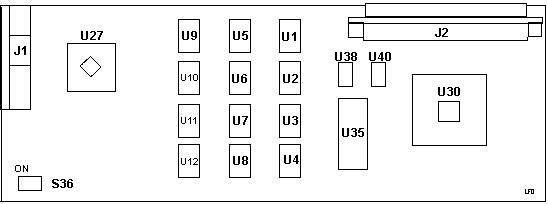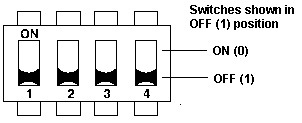|
GXT150L
POWER GXT150L ??? FRU 88G2479 Feature
2660

J1 13W3 video
J2 Local bus header
U1-12 KM428C257T-6
U27 8187135 Pallete DAC
U30 88G2562 |
U32 88G2832
U35 88G2832
U38 50.0000 MHz osc
U40 66.0000 MHz osc
0 |
S36 Switch Positions

I tried to tableize the GXT150L/155L switch settings, but it's
too complex. So ask me for the GXT150L
Switch Settings (PDF)
POWER GXT150L GRAPHICS ADAPTER
This graphics adapter is designed for superior 2D performance in an
AIXwindows 2D environment.
The POWER GXT150L graphics adapter
is an 8-bit single buffer, 256-color, graphics adapter that attaches to
the PowerPC 601 local bus graphics expansion slot and does not use a Micro
Channel slot. When used in conjunction with the AIXwindows 3D feature and
Softgraphics, it provides cost-effective 3D performance. This is
made possible through a design that interfaces video memory and a unique
graphics accelerator chip directly to the PowerPC 601 local bus graphics
expansion slot. The POWER GXT150L is similar to the previously announced
POWER GXT150, but has been designed to fit into the larger graphics expansion
slot in the RISC System/6000 Models 41T and 41W graphics workstations.
The POWER GXT150L graphics adapter
provides 1280x1024, 1152x900, and 1024x768 resolution support, three color
palettes, and hardware window support.
The POWER GXT150L requires AIXwindows
Environment/6000 Version 1.2.5 2D (support for X11R5), or later, and AIX
(R) Version 3.2.5 for RISC System/6000. Refer to Software Announcement
293-489, dated September 21, 1993, for more details on AIXwindows and Softgraphics.
Characteristics:
o Low-cost, high-performance graphical interface acceleration
o 2D hardware acceleration for:
- Points
- Lines
- Triangles
- Rectangles
- Quadrilaterals
- Bit block transfer
o Pattern fill support
o Rectangular and non-rectangular clipping
o 60 to 77Hz refresh modes
o 1280 x 1024, 1152 x 900, and 1024 x 768 resolution
o 256 colors from a palette of 16 million
o Three color palettes
o Hardware window support
o Meets ISO 9241 Part 3 on appropriate displays
o Maximum of one adapter per system can be installed
The PAX 2D Rendering Engine Charles
R. Johns and Taggart Robertson
Introduction
Powerful processors and window managers have enabled application
writers to exploit the
power of graphics. This power has created increased pressure on workstation
suppliers
to provide high–performance graphics solutions to the entry level market
segment.
The POWERstation/POWERserver 250 series workstations along with the
POWER
GXT100 and GXT150 adapters provide such a solution.
The POWER GXT100 and GXT150 are 2D graphics adapters based on
the Pixel
Accelerator for X (PAX) 2D rendering engine and the IBM RGB 530 Palette
Digital to
Analog Converter (Palette–DAC). The PAX engine draws or renders the
graphical data
sent from the 601 processor complex and the RGB 530 displays the data
on the screen.
The GXT100 is an entry–level adapter with memory to support a 1024
x 768 screen. The
GXT150 has added memory to support up to a 1280 x 1024 screen and to
utilize the
multiple color palettes in the IBM RGB 530 Palette–DAC. Both the GXT100
and the
GXT150 are 8–bit adapters which require AIXwindows Environment/6000
Version 1.2.5
2D and AIX Version 3.2.5.
This article presents the design goals, a brief overview
of the GXT100 and GXT150
graphics subsystem organization, a detailed look at the programming
models, and the
architecture of the PAX 2D rendering engine. This article describes
the features and
functions of the PAX rendering engine. All of these features and functions
may not be
exploited by the graphics subsystem.
Design Goals and Considerations
The major goal of the PAX 2D rendering engine is to address
the cost–performance
requirements of the entry workstation market segment. Since X Window
System is the
predominant Graphical User Interface (GUI) on IBM workstations in this
market segment,
the architecture is dedicated to accelerating X Window applications.
This goal, along with
the considerations of time to market and cost, drove the architecture
and design of the PAX
2D rendering engine. The architecture of a graphics subsystem can influence
X Window performance and time to market in several areas. The PAX architecture
targeted three areas: efficient interfaces, simple programming model, and
rendering speed. Details of how each area is
addressed appear in the following sections.
Graphics Subsystem Organization
The POWER GXT100 and GXT150 consists of the PAX 2D rendering
engine, the IBM
RGB 530 Palette–DAC, 1M to 3M bytes of frame buffer memory, and the
initialization Read Only Memory (ROM). Figure 1 shows the complete block
diagram and the major interfaces of the graphics subsystem. The PAX chip
serves as the graphics accelerator as well as the system interface for
the adapter. It contains the control for accessing the initialization ROM,
the Palette–DAC control port, and the video RAM (VRAM) parallel port. PAX
attaches directly to the PowerPC 601 Microprocessor bus. Attaching directly
to the PowerPC 601 bus improves performance by avoiding the latency and
synchronization overhead created when converting from one bus to another.
The 601 bus is a split address and data bus with 32 bits of address and
64 bits of data [1]. The processor uses byte, half–word, or word operations
to access the graphics subsystem. Based on the address of the operation,
PAX directs the access to one of four locations: the internal registers,
the frame buffer (i.e. the VRAM), the RGB 530 Palette–DAC, or the initialization
ROM.
9595 Main Page
|

